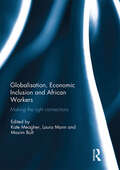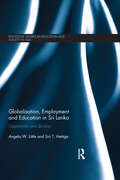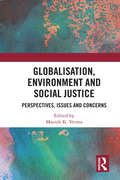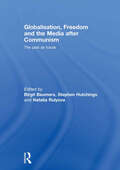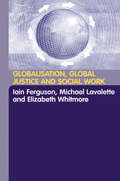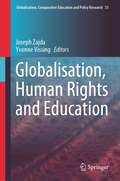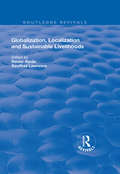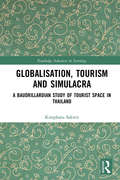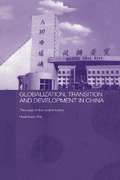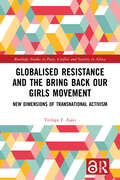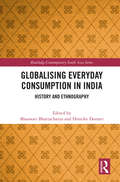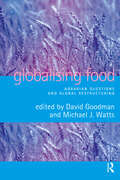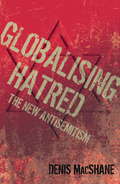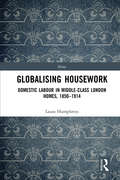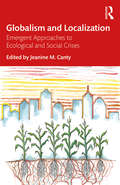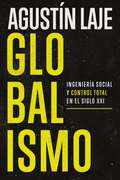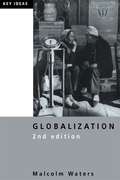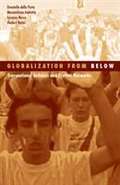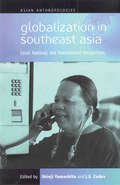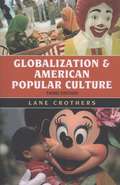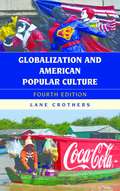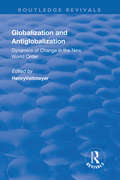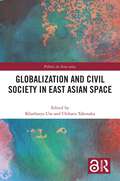- Table View
- List View
Globalisation, Economic Inclusion and African Workers: Making the Right Connections
by Maxim Bolt Kate Meagher Laura MannThis book addresses the question of whether greater inclusion in the global economy offers a solution to rising unemployment and poverty in contemporary Africa. The authors trace the connection between global demographic change and new mechanisms of economic inclusion via global value chains, digital networks, labour migration, and corporate engagement with the bottom of the pyramid, challenging the claim that African workers have become functionally irrelevant to the global economy. They expose the shift of global demand for African workers from formal to increasingly informalised labour arrangements, mediated by social enterprises, labour brokers, graduate entrepreneurs and grassroots associations. Focusing on global employment connections initiated from above and from below, the authors examine whether global labour linkages increase or reduce problems of vulnerable and unstable working conditions within African countries, and considers the economic and political conditions needed for African workers to capture the gains of inclusion in the global economy. This book was previously published as a special issue of the Journal of Development Studies.
Globalisation, Employment and Education in Sri Lanka: Opportunity and Division (Routledge Studies in Education and Society in Asia)
by Angela W. Little Siri T. HettigeSince the late 1970s, Sri Lanka has undergone a socio-economic transformation, from protectionism towards economic liberalisation and increasing integration into the world economy. Through a systematic comparison of these periods of economic change (1956–1977, and 1977 to the present), Angela W. Little and Siri T. Hettige examine the impact of this transformation on education, youth employment and equality of opportunity in Sri Lanka. The book charts Sri Lanka’s shift from a predominantly agricultural economy to one dominated by services and manufacturing, a reduction in unemployment, rising educational and occupational levels, expectations and achievements, and a reduction in poverty. In turn, it reveals a growing role for the private sector and foreign interests in post-secondary education and a modest growth in private education at the primary and secondary levels, as well as widening social disparities in access to qualifications, training and skills. The Sri Lankan experience of, and engagement with, globalisation has been tempered by a long-running ethnic conflict that hindered economic and social development and diverted considerable public funds into defence and war. Now that the war is ‘won’, the challenge is how to invest in human resource development and the fulfilment of the expectations of youth from all ethnic and social groups. This challenge requires serious policy analysis, the generation of more state revenues, the reallocation of existing public resources, and a political commitment to the winning of a sustainable peace and stability. This book makes an important contribution to the broader international literature on the implications of globalisation for education policy and practice, and to the interaction of exogenous and endogenous forces for educational change. It deals with the tension between the high social demand for education and the growing demand for specialised skills in a changing economy. As such, it has a wide interdisciplinary appeal across education policy and politics, Asian education, South Asian society, youth policy, sociology of education, political economy of social change, and globalisation.
Globalisation, Environment and Social Justice: Perspectives, Issues and Concerns
by Manish K. VermaThis volume provides a comprehensive account of the connections between globalisation, environment and social justice. It examines varied dimensions of environmental sustainability; the adverse impact of globalisation on environment and its consequences for poverty, unemployment and displacement; the impacts on marginalised sections such as scheduled castes and tribes and women; and policy frameworks for ensuring environmental sustainability and social justice. The chapters build on detailed case studies from different parts of the world and deal with critical environmental issues such as global emissions, climate change, sustainable development, green politics, species protection, water governance, waste management, food production and governance besides education, inclusivity and human rights. Presenting a range of topics alongside new perspectives and discourses, this interdisciplinary book will be useful to students and researchers of political studies, sociology and environmental studies as well as policymakers and those working in the government and civil society organisations.
Globalisation, Freedom and the Media after Communism: The Past as Future (Routledge Europe-Asia Studies)
by Stephen Hutchings Birgit Beumers Natalia RulyovaThis book examines the fate of post-Soviet press freedom and media culture in the context of the growing impact of globalisation. To understand the complicated situation that has arisen with respect to these issues in post-Soviet space is impossible without collaboration between political scientists, sociologists, cultural analysts, media studies researchers and media practitioners. The book is one of the first attempts to bridge the gaps between political and cultural studies approaches, between textual analysis and audience research, as well as between practitioner-led and scholarly approaches to the post-Soviet media The cumulative impact of the essays contained in this section is to reinforce the intuition which inspired it: that the post-Soviet media remain a highly heterogeneous, complex and dynamic field for investigation. With contributions from scholars and journalists across Europe (including the former Soviet Union), the collection addresses such issues as censorship and elections, the legacy of the Soviet past, terrorism and the media, the post-Soviet business press, advertising and nation building, official press discourse and entrepreneurship, and global formats on Russian television.This book was originally published as a special issue of Europe-Asia Studies.
Globalisation, Global Justice and Social Work
by Michael Lavalette Iain Ferguson Elizabeth WhitmoreGlobalization has become a seemingly unstoppable force over recent decades and, in its wake, global notions of social justice have developed in response to its negative aspects. Neo-liberal economic policies have been a key element in the wider process of globalization, and these policies have had a profound impact on welfare provision and the shape of social work practice. Arising dissatisfaction among users of welfare and social work services is fuelling the search for a new, more radical social work that is firmly rooted in principles of social justice. Globalisation, Global Justice and Social Work explores the global effects of neo-liberal policies on welfare services in different countries, with contributions from social work academics, practitioners and welfare activists around the world. The first section of the book presents case studies of impact of neo-liberalism on welfare systems, social service provision and the practice of social work. In the second section the chapters explore the relationship between social work practice and the struggle for social justice. Authors discuss the personal and political dilemmas they have had to address in seeking to link a personal commitment to social justice with their daily practice as workers and educators in social work. The final section assesses the prospects for social work practice based on notions of social justice, by looking at what can be learned from the experience of previous radical movements as well as from emergent global and local movements.
Globalisation, Human Rights and Education (Globalisation, Comparative Education and Policy Research #51)
by Joseph Zajda Yvonne VissingThis book analyses major discourses of human rights and education. It examines critically major issues confronting human rights and education, both locally and globally. The various chapters analyze the challenges that different societies are faced with, as they attempt to implement, protect and defend democracy, cultural diversity and human rights in schools. The book helps readers to explore their own views and consider more broadly what may be in the best interests of a fair and just society, as envisioned in human rights treaties, human rights education in schools, and cultural diversity.
Globalisation, Localisation and Sustainable Livelihoods
by Geoffrey Lawrence Reidar AlmasThis title was first published in 2002. One of the greatest concerns facing the world is how to ensure that sustainable outcomes are generated as globalization proceeds apace. Quite simply, many people are finding their life chances deteriorating - with resistance to globalization being a common response. The question is: is it possible to guarantee sustainable livelihoods for individuals, families and communities as global processes increasingly shape local social relations? This volume is a collection of 16 chapters from leading rural sociologists and human geographers based in Europe, Australasia, and the Americas. The book, in three parts, deals with globalization and food; the restructuring of local agriculture; and communities and resistance in a globalizing world. The introduction to the book compares and contrasts the various experiences of communities in countries such as Australia, Brazil, Finland, Norway, South Africa and the United States as they "struggle" to cope with globalization and its effects. Each chapter discusses options to ameliorate the local consequences of global change.
Globalisation, Nation-Building and History Education (Globalisation, Comparative Education and Policy Research #40)
by Joseph Zajda John WhitehouseThis book uses historiography and discourse analysis to provide a new insight into understanding the nexus between ideologies, the state, and nation-building—as depicted in history school textbooks. It focuses on the interpretation of social and political change, significant events, and examining possible new biases and omissions in school textbooks. The ‘Europeanization’ of history textbooks in the EU is an example of western-dominated Grand Narrative of pluralist democracy, multiculturalism, and human rights, according to the canon of a particularly European dimension. Various public debates in the USA, China, the Russian Federation (RF), Japan, and elsewhere, dealing with understandings of a nation-building, national identity, and history education point out to parallels between the political significance of school history and the history education debates globally.The book demonstrates that the issue of national identity and balanced representations of the past continue to dominate the debate surrounding the goals, dominant ideologies and content of history textbooks, and historical narratives. It concludes that competing discourses and ideologies will continue to define and shape the nature and significance of historical knowledge, ideologies and the direction of values education in history textbooks. This book provides an easily accessible, practical, yet scholarly insights into local and global trends in the field of history education, and should be required reading for a broad spectrum of users, including policy-makers, academics, graduate students, education policy researchers, administrators, and practitioners.
Globalisation, Tourism and Simulacra: A Baudrillardian Study of Tourist Space in Thailand (Routledge Advances in Sociology)
by Kunphatu SakwitThis book draws on the thought of Baudrillard to explore the effects of globalisation and tourism in a Thai context. Arguing that tourism does not necessarily erode local culture but that local culture can in fact be recreated through globalisation and tourism, the author employs studies of the Damnoen Saduk and Pattaya floating markets, showing them to be simulations of Thai culture that undergo changes of form, cultural content and activity, through various stages of representation. With a focus on the themes of the circulation of value and signs, the play of differences and orders of simulacra, this volume examines the extent to which Baudrillard’s theory can apply in a non-western context and in relation to tourism. A study of consumption, tourism and the relations between the global and the local, Globalisation, Tourism and Simulacra will appeal to scholars of sociology and geography with interests tourism, globalisation and social theory.
Globalisation, Transition and Development in China: The Case of the Coal Industry (Routledge Studies on the Chinese Economy #Vol. 11)
by Rui HuaichuanBased on extensive original research, Globalisation, Transition and Development in China explains China's development strategy and its underlying forces, and the success of this strategy. It examines China's gradualist approach which emphasizes development first and regards transition and globalization as secondary, enacting liberalization of domestic markets and integration into the world economy in a paced way, avoiding dramatic changes which might impede or even reverse development, and argues that this approach is broadly correct. It considers China's failures, including the failure to build large globally competitive corporations despite the intention to do this, and shows how China's economic strategy has been implemented in detail with a case study of the large and important coal industry.
Globalised Resistance and the Bring Back Our Girls Movement: New Dimensions of Transnational Activism (Routledge Studies in Peace, Conflict and Security in Africa)
by Titilope F. AjayiThis book uncovers how women’s movements in the Global South are changing the face of transnational activism in their mobilisations against militarism and conflict-related gender violence.Drawing on the case study of the Bring Back Our Girls (BBOG) movement established by Nigerian women for the rescue of Nigerian schoolgirls abducted in 2014 by violent extremist group Boko Haram, the book argues that BBOG is one of several emerging forms of transnational resistance in Africa that are breaking old moulds and forging new directions for social movements globally. The book argues that current research on social movements focuses too much on professional advocacy by formal civil society organisations and networks in the Global North. In doing so, it misses the increasingly spontaneous, mass-based protests initiated and led by Global South actors grounded in Global South contexts. Unpacking the workings of the BBOG movement, both internationally and regarding on-the-ground daily struggles in Nigeria, the book highlights their considerable implications for the practice and study of international politics.This book is an important read for researchers of international relations, decolonisation, social movements, and transnational human rights activism. Activists and leaders of social movements will also find the policy implications highlighted by the book useful.
Globalising Everyday Consumption in India: History and Ethnography (Routledge Contemporary South Asia Series)
by Bhaswati BhattacharyaThis book brings together historical and ethnographic perspectives on Indian consumer identities. Through an in-depth analysis of local, regional, and national histories of marketing, regulatory bodies, public and domestic practices, this interdisciplinary volume charts the emergence of Indian consumer society and discusses commodity consumption as a main feature of Indian modernity. The nationalist discourse was formed by starting with the morality of consumption patterns feeding into middle-class identity; the chapters demonstrate how different strata of society were targeted as markets for everyday commodities associated with global lifestyles early on. A section of the book illustrates how a new group of professionals engaged in advertising trying to create a market shaped tastes and discourses and how campaigns provided a range of consumers with guidance on ‘modern lifestyles’. Chapters discussing advertisements for consumables, like coffee and cooking oil, show these to be part of new public cultures. The ethnographic chapters focus on contemporary practices and consumption as a main marker of class, caste and community. Throughout the book consumption is shown to determine communal identities, but some chapters also highlight how it reshapes intimate relationships. The chapters explore the middle-class family, microcredit schemes, and metropolitan youth cultures as sites in which consumer citizenship is realised. The book will be of interest to readers from a range of disciplines, including anthropology, history, geography, sociology, South Asian studies, and visual cultures.
Globalising Food: Agrarian Questions and Global Restructuring
by David Goodman Michael WattsIn an increasingly global world, societies are being provisioned from a bewildering array of sources as new countries and new food commodities are drawn into international markets. Globalising Food provides an innovative contribution to the area of political economy of agriculture, food and consumption through a revealing investigation of the globalisation and restructuring of localised agricultural sectors and food systems.The book draws on new theoretical perspectives and wide-ranging case studies from Britain, the USA, India, South Africa, New Zealand and Latin America. The key themes addresses range from giant multinational food corporations, rural industrialisation and World Bank policies, to the regulation of pollution, labour relations, urban food politics and environmental sustainability. Globalising Food offers important insights into the problems, consequences and limits of the industrialisation of agriculture and the provisioning of food in a global world as we approach the new millenium.
Globalising Hatred: The New Antisemitism
by Denis MacShaneA hard-hitting essay combined with factual reportage on the new anti-semitism throughout Europe.This book argues that what the 21st century now faces is an ideological assault based on hatred of Jews which is as serious as any major threat to universal values as the world has faced. Anti-semitism is the visible language and action of a deeper threat to world peace, to the achievements of the human spirit we call the Enlightenment, and undermines vital work to address problems like poverty and the challenges of the environment.Denis MacShane's survey of 21st century anti-semitism is based on the All-Party Commission of Enquiry which was chaired by the author in the UK. His book considers examples in Europe and how anti-semitism is now a linking mechanism between different extremisms, usually but not exclusively of the Right. It lists in detail the anti-semitism in national party politics, including the European Parliament, and it examines how Holocaust denial is not a question of liberal free-expression issues but an organised ideological position. The new anti-semitism arises from three main sources: state-sanctioned anti-semitism; that of terrorist movements like Al Qaeda; and that of political movements like the Muslim Brotherhood and its off-shoots and spokesmen.The book is both a cri de coeur for a new tolerance and a resolution to throw light on 21st century anti-semitism, which has left Europe to become a new form of mobilising politics across many continents.
Globalising Hatred: The New Antisemitism
by Denis MacShaneA hard-hitting essay combined with factual reportage on the new anti-semitism throughout Europe.This book argues that what the 21st century now faces is an ideological assault based on hatred of Jews which is as serious as any major threat to universal values as the world has faced. Anti-semitism is the visible language and action of a deeper threat to world peace, to the achievements of the human spirit we call the Enlightenment, and undermines vital work to address problems like poverty and the challenges of the environment.Denis MacShane's survey of 21st century anti-semitism is based on the All-Party Commission of Enquiry which was chaired by the author in the UK. His book considers examples in Europe and how anti-semitism is now a linking mechanism between different extremisms, usually but not exclusively of the Right. It lists in detail the anti-semitism in national party politics, including the European Parliament, and it examines how Holocaust denial is not a question of liberal free-expression issues but an organised ideological position. The new anti-semitism arises from three main sources: state-sanctioned anti-semitism; that of terrorist movements like Al Qaeda; and that of political movements like the Muslim Brotherhood and its off-shoots and spokesmen.The book is both a cri de coeur for a new tolerance and a resolution to throw light on 21st century anti-semitism, which has left Europe to become a new form of mobilising politics across many continents.
Globalising Housework: Domestic Labour in Middle-class London Homes,1850-1914 (Home)
by Laura HumphreysThis book shows how international influences profoundly shaped the ‘English’ home of Victorian and Edwardian London; homes which, in turn, influenced Britain’s (and Britons’) place on the world stage. The period between 1850 and 1914 was one of fundamental global change, when London homes were subject to new expanding influences that shaped how residents cleaned, ate, and cared for family. It was also the golden age of domesticity, when the making and maintaining of home expressed people’s experience of society, class, race, and politics. Focusing on the everyday toil of housework, the chapters in this volume show the ‘English’ home as profoundly global conglomeration of people, technology, and things. It examines a broad spectrum of sources, from patents to ice cream makers, and explores domestic histories through original readings and critiques of printed sources, material culture, and visual ephemera.
Globalism and Localization: Emergent Solutions to Ecological and Social Crises
by Jeanine M. CantyConsidering the context of the present ecological and social crisis, this book takes an interdisciplinary approach to explore the relationship between globalism and localization. Globalism may be viewed as a positive emergent property of globalization. The latter depicts a worldwide economic and political system, and arguably a worldview, that has directly increased planetary levels of injustice, poverty, militarism, violence, and ecological destruction. In contrast, globalism represents interconnected systems of exchange and resourcefulness through increased communications across innumerable global diversities. In an economic, cultural, and political framework, localization centers on small-scale communities placed within the immediate bioregion, providing intimacy between the means of production and consumption, as well as long-term security and resilience. There is an increasing movement towards localization in order to counteract the destruction wreaked by globalization, yet our world is deeply and integrally immersed within a globalized reality. Within this collection, contributors expound upon the connection between local and global phenomenon within their respective fields including social ecology, climate justice, ecopsychology, big history, peace ecology, social justice, community resilience, indigenous rights, permaculture, food justice, liberatory politics, and both transformative and transpersonal studies.
Globalismo: Ingeniería social y control total en el siglo XXI
by Agustin LajeDesvela los mecanismos ocultos de la dominación mundial con Globalismo: Ingeniería social y control total en el siglo XXI. El exitoso autor Agustín Laje desentraña magistralmente la malvada realidad de nuestro mundo moderno e ilumina las tinieblas de las fuerzas de poder que tratan de controlar a la humanidad. El globalismo no es globalización, sino una demoledora ideología que supone el más ambicioso proyecto de ingeniería social y control total en curso. Institucionalizada en organizaciones que, por definición, no tienen ni patria, ni territorio ni pueblo, esta ideología pretende parir un régimen político antidemocrático de alcance global. Así la soberanía de las naciones se redistribuye entre organizaciones supranacionales como el Foro Económico Mundial o la ONU con su Agenda 2030, liberadas de las limitaciones de los intereses particulares de los pueblos, para coordinar las transformaciones necesarias para nuestra «supervivencia». El globalismo también propone nuevas formas de legitimidad basadas en la tecnocracia y la supuesta filantropía de organizaciones como la Fundación Gates, la Open Society de Soros, y la Fundación Rockefeller.En esta obra, Agustín Laje explica magistralmente el origen y la formación del contrato social de nuestros Estados nacionales sobre una base democrática, mostrando cómo el globalismo busca culpabilizar estas estructuras para llevarnos a un callejón sin salida, donde todo se cede a una gobernanza global no representativa, la máxima expresión de la oligarquía de unos pocos privilegiados a los que nadie votó, y que ante nadie rinden cuentas pero que pretenden dirigir el destino del planeta.El autor llama a todos los actores sociales, políticos, religiosos e intelectuales a unirse contra el globalismo. La paradoja de que los patriotas olviden sus fronteras para esta batalla cultural adquiere un nuevo significado. Conocer la verdad y denunciar la mentira es un arma valiosa que este libro ofrece.GlobalismUncover the secret workings of world domination with Globalism: Social Engineering and Total Control in the 21st Century. Best-selling author Agustín Laje masterfully unravels the sinister reality of our modern world and sheds light on the darkness of the forces of power that seek to control humanity.Globalism is not globalization, but rather a devastating ideology representing the most ambitious social engineering and total-control project currently underway.Institutionalized by organizations such as the World Economic Forum or the UN with its Agenda 2030, Globalism also promotes new forms of legitimacy based on &“technocracy&” and the supposed philanthropy of organizations such as the Gates Foundation, Soros&’ Open Society, and the Rockefeller Foundation.In this book, Agustín Laje skillfully explains the origin and formation of the social contract of our nation-States based on democracy, demonstrating how globalism seeks to blame these structures in order to steer us into a dead-end, where everything is handed over to a non-representative global governance. This represents the ultimate expression of an oligarchy formed by a few privileged elites who were elected by no one and are accountable to nobody, yet aim to dictate the destiny of the planet.The author calls on all social, political, religious, and intellectual figures to unite against globalism. The paradox of patriots disregarding their borders for this cultural battle takes on a new significance. Knowing the truth and denouncing the lie is a valuable weapon that this book offers.
Globalization (Key Ideas)
by Malcolm WatersThe constraints of geography are shrinking and the world is becoming a single place. Globalization and the global society are increasingly occupying the centre of sociological debates. Widely discussed by journalists and a key goal for many businesses, globalization has become a buzz-word in recent years. In this extensively revised and restructured new edition of Globalization , Malcolm Waters provides a user-friendly introduction to the main arguments about the process, including a chapter on the critiques of the globalization thesis that have emerged since the first edition was published.
Globalization From Below: Transnational Activists And Protest Networks (Social Movements, Protest And Contention Series #82)
by Donatella Della Porta Herbert Reiter Lorenzo Mosca Massimillano AndrettaThis volume is the result of a long-lasting collaboration that has already produced two other books on the "new global" movements, in particular on the anti-G8 demonstrations in Genoa in 2001: Global, Noglobal, New Global m Italian (Andretta et al. 2002) and Global No Global in German (Andretta et al. 2003). We are grateful to those who helped us produce those two books. Although some of the ideas developed in those previous works are reported in this volume, here we analyze a new set of data on the first European Social Forum in 2002.
Globalization In Southeast Asia
by Shinji Yamashita J. S. EadesThe rapid postwar economic growth in the Southeast Asia region has led to a transformation of many of the societies there, together with the development of new types of anthropological research in the region. Local societies with originally quite different cultures have been incorporated into multi-ethnic states with their own projects of nation-building based on the creation of "national cultures" using these indigenous elements. At the same time, the expansion of international capitalism has led to increasing flows of money, people, languages and cultures across national boundaries, resulting in new hybrid social structures and cultural forms. This book examines the nature of these processes in contemporary Southeast Asia with detailed case studies drawn from countries across the region, including Indonesia, Malaysia, the Philippines, Singapore and Thailand. At the macro-level these include studies of nation-building and the incorporation of minorities. At the micro-level they range from studies of popular cultural forms, such as music and textiles to the impact of new sects and the world religions on local religious practice. Moving between the global and the local are the various streams of migrants within the region, including labor migrants responding to the changing distribution of economic opportunities and ethnic minorities moving in response to natural disaster.
Globalization and American Popular Culture (Globalization)
by Lane CrothersNow in a fully revised and updated edition, this concise and insightful book explores the ways American popular products such as movies, music, television programs, fast food, sports, and even clothing styles have molded and continue to influence modern globalization. Lane Crothers offers a nuanced examination of both the appeal of American products worldwide and the fear and rejection they induce in many people and nations around the world. The author defines what we mean by "popular culture," how popular culture is distinguished from the generic concept of "culture," and what constitutes "American" popular culture. Tracing how U.S. movies, music, and TV became dominant in world popular culture, Crothers also considers the ways in which non-visual products like fast-food franchises, sports, and fashion have become ubiquitous. Concluding with a projection of the future impact of American popular culture, this book makes a powerful argument for its central role in shaping global politics and economic development.
Globalization and American Popular Culture (Globalization)
by Lane CrothersNow in a fully revised and updated edition, this concise and insightful book explores the ways American popular products such as movies, music, television programs, fast food, sports, and even clothing styles have molded and continue to influence modern globalization. Lane Crothers offers a thoughtful examination of both the appeal of American products worldwide and the fear and rejection they induce in many people and nations around the world. The author defines what we mean by "popular culture," how popular culture is distinguished from the generic concept of "culture," and what constitutes "American" popular culture. Tracing how U.S. movies, music, and TV became dominant in world popular culture, Crothers also considers the ways in which non-visual products like fast-food franchises, sports, and fashion have become ubiquitous. He also presents a fascinating set of case studies that highlight the varied roles American products play in a range of different nations and communities. Concluding with a projection of the future impact of American popular culture, this book makes a powerful argument for its central role in shaping global politics and economic development.
Globalization and Antiglobalization: Dynamics of Change in the New World Order (The\international Political Economy Of New Regionalisms Ser.)
by Jonathan RutherfordThis title was first published in 2003. Globalisation can be seen to provide the context for epoch-defining changes in social and economic forms of organisation. However, it has also changed the context for and the organisational forms of politics, unleashing forces in support of, and in opposition to, the globalisation dynamic. This text examines the dynamics of change and development in two regions of the world economy, Latin America and Asia, and is a series of explorations into the forces, their political dynamics, and the responses of governments and citizens. The focus of the explorations, and regional case studies, is on the role of the nation-state, international organisations and social movements.
Globalization and Civil Society in East Asian Space (Politics in Asia)
by Khatharya Um Chiharu TakenakaThis book critically examines the impact of globalization, changing power dynamics, migration, and evolving rights regimes on regional order, discourse of national governance, state and society relations, and the development of civil society in East Asia.Providing a textured, critical reading of East Asia as an economically, socially, and politically dynamic region, this book also presents the region as one shaped simultaneously by progressive as well as regressive pulls. Attentive to prevailing issues as well as to states’ and civil societies’ responses to them, it focuses on changing societies and politics in East Asia, particularly on shifting notions of citizenship, nationhood, and peoplehood. The contributions feature new and timely conclusions drawn from multidisciplinary fields including law, public policy, sociology, Asian studies, gender, sexuality, and ethnic studies and include direct testimonies from citizens of East and Southeast Asia.Globalization and Civil Society in East Asian Space will appeal to students and scholars of sociology, political science, and Asian studies more broadly.
